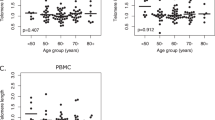Abstract
Prognosis of carcinoma of the larynx is currently based on the morphologic analysis of the tumor extent, differentiation grading and type of microscopic invasion. The DNA ploidy status and the cell proliferation activity may give complementary information about the prognosis. Telomerase may be used as a measure of tumor proliferation. The aim of this work was to investigate the probable application of telomerase as a measure of cell immortalization as well as DNA ploidy as a measure of cell proliferation in the prognosis of patients with laryngeal carcinoma. The work was carried out as a prospective observational study that included 35 patients with laryngeal carcinoma who were treated surgically at Ain Shams University Hospitals, Cairo, Egypt. Flowcytometric analysis and biochemical assay of telomerase using human Telomerase Reverse Transcriptase (hTERT) mRNA assay by RT-PCR in resected specimens were done. The proliferative indices in different parts of the tumor were found to be significantly different from each other, with those of tumor edges being the highest. The ploidy status at the edge of the tumor was significantly different between surviving and non-surviving patients, while the tumor core proliferative index was found to be significantly lower in patients without recurrence than those with recurrence. A gradient of telomerase levels was noticed, with levels from tumor cores being the highest followed by tumor edges, resection margins and the lowest levels in lymph nodes. Multivariate analysis showed hTERT levels in tumor edges to significantly affect survival. Both Flowcytometric parameters and telomerase activity may be useful as a prognostic factor for survival in patients with laryngeal carcinoma. Telomerase activity may be used for biologic demarcation for conservational laryngeal surgery, as well as a ‘spectral’ marker.
Similar content being viewed by others
References
Barona de Guzmán R, Martorell MA, Basterra J, Armengot M, Alvares-Valdés R, Garin L (1993) Prognostic value of histopathological parameters in 51 supraglottic squamous cell carcinomas. Laryngoscope 103:538–540.
Beattie TL, Zhou W, Robinson MO, Harrington L. (1998) Reconstitution of human telomerase activity in vitro. Curr. Biol. 8:177–180.
Curran AJ, Gullane PJ, Irish J, Macmillan C, Freeman Jeremy, Kamel-Reid S (2000) Telomerase activity is upregulated in laryngeal squamous cell carcinoma. Laryngoscope 110:391-396.
Curran AJ, St. Dennis K, Irish J, Gullane PJ, McMillan C, Kamel-Reid S. (1998) Telomerase activity in oral squamous cell carcinoma. Arch Otolaryngol Head Neck Surg 124:784-788.
El-Naggar AK, Lopez-Varela V, Luna MA, Weber R, Batsakis JG. (1992) Intratumoral DNA content heterogeneity in laryngeal squamous cell carcinoma. Arch Otolaryngol Head Neck Surg 118:169–173.
Feinstein AR. (1985) Diagnostic and Spectral Markers In: Clinical Epidemiology. The Architecture of Clinical Research, p. 626, Igaku-Shoin/Saunders, Tokyo.
Fleming ID, Cooper JS, Henson DE, Hutter RVP, Kennedy BJ, Murphy GP, O’Sullivan B, Sobin LH, Yarbro JW. (1997) Cancer survival analysis: Multivariate methods. In: AJCC Cancer Staging Manual, 5th ed., p.15–16, Lippincott-Raven, Philadephia.
Goldsmith M, Cresson D, Postma D, Askin F and Pillsbury H (1986) Significance of ploidy in laryngeal cancer. Am J Surg 152:396–402.
Hohaus S, Cavallo S, Bellacosa A, Genuardi M, Galli J, Cadoni G, Almadori G, Lauriola L, Litwin S, Maurizi M, Neri G (1996) Telomerase activity in human laryngeal squamous cell carcinoma. Clin Cancer Res 2:1895–1900
Holm LE (1982) Cellular DNA amounts of squamous cell carcinomas of the head and neck region in relation to prognosis. Laryngoscope 92:1064–1069.
Holt SE, Wright WE, Shay JW (1996) Regulation of telomerase activity in immortal cell lines. Mol Cell Biol. 16:2932-2939.
Jin Y-T, Kayser S, Kemp BL, Ordonez NG, Tucker SL, Clayman GL, Goepfert H, Luna MA, Batsakis JG, El-Naggar AK (1998) The Prognostic Significance of the Biomarkers p21 WAF1/CIP1, p53, and bcl-2 in Laryngeal Squamous Cell Carcinoma. Cancer 82:2159-2165.
Kim NW, Piatyszek MA, Prowse KR, Harley CB, West MD, Ho PLC, Coviello GM, Wright WE, Weinrich SL, Shay JW (1994) Specific association of human telomerase activity with immortal cells and cancer. Science 266:2011-2015.
Luzar B, Poljak M, Marin IJ, Fishinger J, Gale N (2001) Quantitative measurement of telomerase catalytic subunit (hTERT) mRNA in laryngeal squamous cell carcinomas. Anticancer Res 21:4011-4015.
McKenzie KE, Umbricht CB, Sukumar S (1999) Applications of telomerase research in the fight against cancer. Mol Med Today 5:114-122.
Meyerson M, Counter CM, Eaton EN, Ellisen LW, Steriner P, Caddle SD, Ziaugra L, Beijersbergen RL, Davidoff MJ, Liu Q (1997) hEST2, the putative human telomerase catalytic subunit gene, is up-regulated in tumor cells and during immortalization. Cell 90:785-795
Patt BS, Close LG, Vuitch F (1993) Prognostic Significance of Sinus Histiocytosis in Metastatic Laryngeal Cancer. Laryngoscope 103:498–502.
Rabinovitch PS (1991) Multicycle: A Program for DNA content and cell cycle analysis. Phoenix Flow Systems, San Diego, CA, 92121.
Ruá S, Comino A, Fruttero A, Cera G, Semeria C, Lanzillotta L, Boffetta P (1991) Relationship between Histologic Features, DNA Flow Cytometry, and Clinical Behavior of Squamous Cell Carcinoma of the Larynx. Cancer 67; 141-149.
Shampay J. Szostak JW, Blackburn EH. (1984) DNA sequences of telomeres maintained in yeast. Nature 310:154–157.
Welkoborsky HJ, Hinni M, Dienes HP, Mann WJ (1995) Predicting recurrence and survival in patients with laryngeal cancer by means of DNA cytometry, tumor front grading and proliferating markers. Ann Otol Rhinol Laryngol 104:503-510.
Wolfensberger M (1992) Using Cox’s Proportional hazards model for prognostication in carcinoma of the upper aero-digestive tract. Acta Otolayngologica 112:376-382
Author information
Authors and Affiliations
Corresponding author
Rights and permissions
About this article
Cite this article
El Samny, T., El Halaby, H., El Fiky, L. et al. Prognostic value of telomerase and DNA ploidy in laryngeal carcinoma. Eur Arch Otorhinolaryngol 262, 799–803 (2005). https://doi.org/10.1007/s00405-004-0904-z
Received:
Accepted:
Published:
Issue Date:
DOI: https://doi.org/10.1007/s00405-004-0904-z




